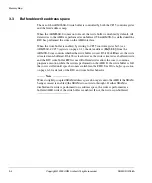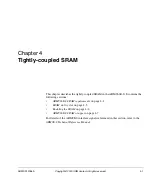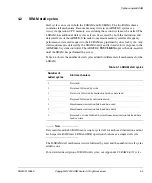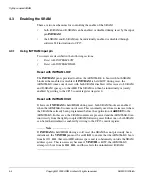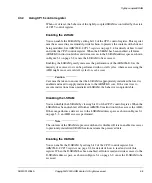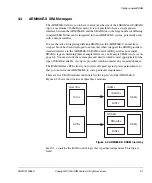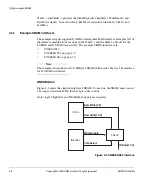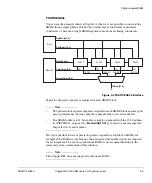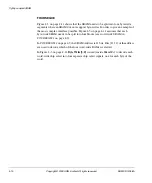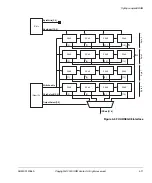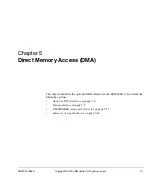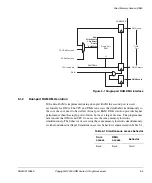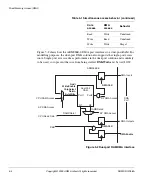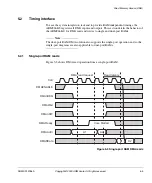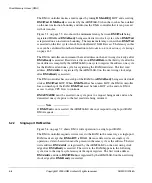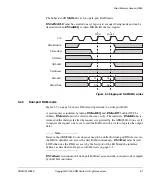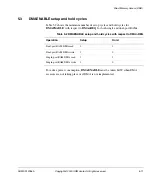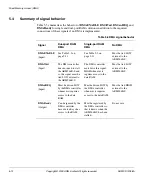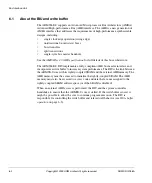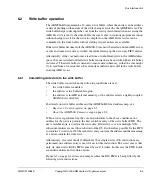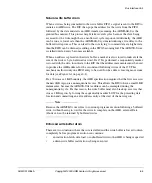
Direct Memory Access (DMA)
5-2
Copyright © 2000 ARM Limited. All rights reserved.
ARM DDI 0186A
5.1
About the DMA interface
A DMA port is provided on the ARM966E-S. You can connect this port to the D-SRAM
in the ARM966E-S. This allows direct access to the D-SRAM from outside the
ARM966E-S boundary. If this feature is not required the DMA port is tied off in the
RTL and made redundant. You have the option of interfacing the DMA port to a
dual-port RAM or a single-port RAM, providing the ability to choose the solution that
best meets area, performance, and software requirements.
The DMA port enables direct access to the data RAM, bypassing the CPU core. The
ARM966E-S provides the control logic to access the RAM. The implementation of a
DMA controller is application-specific and so any DMA control logic is instantiated
outside of the ARM966E-S macrocell boundary.
Figure 3-1 on page 3-2 shows DMA addresses directly map to the RAM location in the
data RAM 64MB address space. The RAM controller in the ARM966E-S uses bits
[31:26] of the CPU data address to decode Data RAM address space access. Bits
[31:26], however, are not required to be driven by the DMA controller because DMA
access is always to this address space. RAM aliasing occurs for DMA access in the same
way as aliasing occurs for CPU accesses. See
Tightly-coupled SRAM address space
page 3-3 for more information.
Note
The decision to connect to the DMA port, and to a particular type of RAM, is made prior
to synthesis.
5.1.1
Single-port RAM DMA solution
DMA accesses to a single-port RAM must be done through the same interface that the
CPU uses to access the RAM. CPU accesses to the RAM must be prevented while DMA
transfers are taking place. This is done by stalling the core for the duration of the DMA
transfer. The DMA controller requests access to the D-RAM by asserting
DMAWait
.
When the CPU has been stalled on the next instruction boundary, the ARM966E-S
asserts
DMAReady
to notify to the DMA controller that it now has ownership of the
RAM and can proceed with the transfer.
The single-port RAM DMA solution must be used where the die area of a dual-port
RAM is not acceptable and the performance impact of stalling the core during DMA
transfers is acceptable.
Figure 5-1 on page 5-3 shows how the ARM966E-S DMA port interfaces to a
single-port RAM.
Summary of Contents for ARM966E-S
Page 6: ...Contents vi Copyright 2000 ARM Limited All rights reserved ARM DDI 0186A ...
Page 20: ...Introduction 1 4 Copyright 2000 ARM Limited All rights reserved ARM DDI 0186A ...
Page 48: ...Tightly coupled SRAM 4 12 Copyright 2000 ARM Limited All rights reserved ARM DDI 0186A ...
Page 80: ...Bus Interface Unit 6 20 Copyright 2000 ARM Limited All rights reserved ARM DDI 0186A ...
Page 118: ...Debug Support 8 26 Copyright 2000 ARM Limited All rights reserved ARM DDI 0186A ...
Page 130: ...Test Support 10 8 Copyright 2000 ARM Limited All rights reserved ARM DDI 0186A ...
Page 142: ...Instruction cycle timings 11 12 Copyright 2000 ARM Limited All rights reserved ARM DDI 0186A ...
Page 158: ...Signal Descriptions A 16 Copyright 2000 ARM Limited All rights reserved ARM DDI 0186A ...
Page 176: ...AC Parameters B 18 Copyright 2000 ARM Limited All rights reserved ARM DDI 0186A ...

